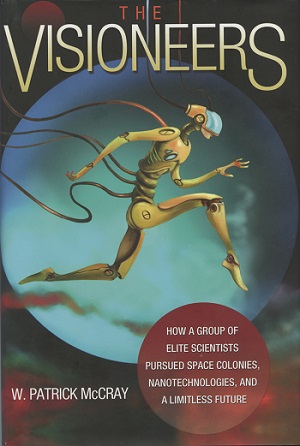Centauri Dreams
Imagining and Planning Interstellar Exploration
Asteroids in our Future
NASA has released an Asteroid Initiative Request for Information on the issue of asteroid retrieval. It’s an interesting document both in its audience — the agency is making a point about soliciting comments not only from academics, scientists and engineers but the general public — but also because of the issues it explores. Being sought are ideas on how best to capture an asteroid, land an astronaut on one, and change its orbit, not necessarily in that order. The Los Angeles Times quotes NASA associate director Robert Lightfoot on the public component of NASA’s initiative:
“Too often, by the time we present a mission to the public, it has already been baked, and there’s not much we can change. This is your chance to present your ideas to us before the mission is baked.”
If you’re interested in contributing, move quickly, for the deadline for responses is July 18, with a workshop to follow in September.
The creation of a Solar System-wide infrastructure will necessarily precede any interstellar probes, if only because the methods we are studying to make such a probe happen all involve large construction projects in interplanetary space and resource retrieval from places as far away as the gas giants. But making the early infrastructure viable could well be the result of asteroid activities through companies like Planetary Resources and Deep Space Industries, or whoever manages to sustain an economic model for exploiting these interesting objects.
Asteroids are compelling targets for mining everything from gold, iron, nickel and platinum to water that can be extracted to support human settlements. But the case for developing our asteroid capabilities is also wrapped up in planetary defense, and it’s interesting to see this section of the NASA RFI:
Asteroid Deflection Demonstration: NASA is interested in concepts for deflecting the trajectory of an asteroid using the robotic Asteroid Redirection Vehicle (ARV) that would be effective against objects large enough to do significant damage at the Earth’s surface should they impact (i.e. > 100 meters in size). These demonstrations could include but [are] not limited to: a. Use of the ARV to demonstrate a slow push trajectory modification on a larger asteroid. b. Use of the ARV to demonstrate a “gravity tractor” technique on an asteroid. c. Use of ARV instrumentation for investigations useful to planetary defense (e.g. sub-surface penetrating imaging) d. Use of deployables from the ARV to demonstrate techniques useful to planetary defense (e.g. deployment of a stand alone transponder for continued tracking of the asteroid over a longer period of time).
10,000 NEOs and Counting
All of this is wrapped up inside the larger agency effort to capture and de-spin an asteroid and redirect it into translunar space, as described in the document. Just after the release of the NASA Request for Information on June 18, we learned that the 10,000th near-Earth object, asteroid 2013 MZ5, was detected by the Pan-STARRS-1 telescope in Hawaii. Near-Earth objects (NEOs) can approach the Earth’s orbital distance within 45 million kilometers. Known NEOs are as large as 40 kilometers (1036 Ganymed) or as small as a meter in diameter. Asteroid 2013 MZ5 turns out to be about 300 meters across and is not in an orbit that is considered hazardous.
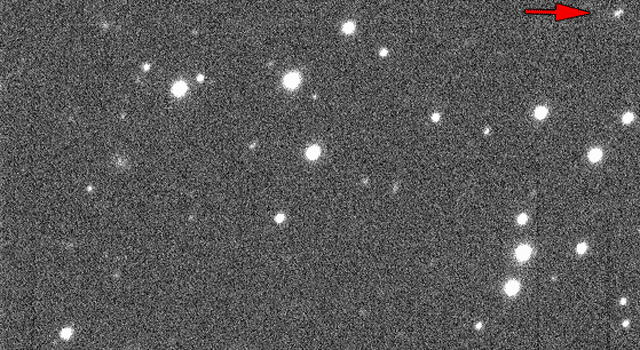
Image: Asteroid 2013 MZ5 as seen by the University of Hawaii’s PanSTARR-1 telescope. In this animated gif, the asteroid moves relative to a fixed background of stars. Asteroid 2013 MZ5 is in the right of the first image, towards the top, moving diagonally left/down. Credit: PS-1/UH.
I’ve been reading Don Yeomans’ book Near-Earth Objects: Finding Them Before They Find Us (Princeton University Press, 2012), an excellent overview of the field that I’ll be reviewing here in coming weeks. In this JPL news release Yeomans, manager of NASA’s Near-Earth Object Program Office at JPL, comments on the overall effort to track down NEOs:
“The first near-Earth object was discovered in 1898. Over the next hundred years, only about 500 had been found. But then, with the advent of NASA’s NEO Observations program in 1998, we’ve been racking them up ever since. And with new, more capable systems coming on line, we are learning even more about where the NEOs are currently in our solar system, and where they will be in the future.”
A glimpse of that future is provided by Lindley Johnson, who is part of NASA’s Near-Earth Object Observations Program. Johnson notes the significance of finding the 10,000th NEO but adds “…there are at least 10 times that many more to be found before we can be assured we will have found any and all that could impact and do significant harm to the citizens of Earth.” So we keep looking. NASA expects there are about 15,000 NEOs that are 140 meters in size and more than a million that reach 30 meters. The latter is a figure the agency cites as being the minimum size needed to cause ‘significant devastation’ in populated areas.
The news release has this to say about the NEOs we’ve already discovered:
Of the 10,000 discoveries, roughly 10 percent are larger than six-tenths of a mile (one kilometer) in size – roughly the size that could produce global consequences should one impact the Earth. However, the NASA NEOO program has found that none of these larger NEOs currently pose an impact threat and probably only a few dozen more of these large NEOs remain undiscovered.
The Near-Earth Object Observations Program is indeed, as Yeomans says, ‘racking them up.’ Working through the Catalina Sky Survey, the University of Hawaii’s Pan-STARRS survey and MIT’s LINEAR survey, NEOs are being discovered at a rate of about 1,000 per year. All observations flow to the Minor Planet Center in Cambridge MA in an effort that is clearly making progress on finding and cataloging objects. We now need to emphasize the effort to study the kind of deflection and trajectory-altering techniques NASA describes in the new RFI.

Philosophy, Intention and GJ 667C
The star Gliese 667C is as intriguing as it is because it underlines in triplicate the ‘habitability’ question, which surfaces every time a planet is discovered in a zone around its star where liquid water could exist on the surface. This is the classic definition of ‘habitable zone,’ meaning not so much a place where humans could live — we have no knowledge of other conditions on these worlds, knowing little more than their minimum mass — but a place where a basic condition for life as we know it is possible.
I’m much in favor of considering exotic environments for life, and these would include venues ranging from the upper clouds of Venus to the depths of the icy gas giant satellites in our own system. But when we read about ‘habitable zones’ in most scientific papers, we’re usually falling back on the liquid water criterion because it’s hard enough to search for any kind of life on a distant world, much less a kind that we don’t even know exists. Liquid water is a starting point, a baseline in the search for life-supporting worlds, but it hardly means the hunt for life stops there.
My own speculations about systems like GJ 667C become purely imaginative. I notice how many systems we’re finding that have ‘super-Earths,’ a category of planet that doesn’t even appear in our own Solar System. I also note that small M-dwarfs can produce clusters of planets that, in the case of GJ 667C, are close enough that three can be squeezed into the habitable zone. Imagine a civilization emerging on one such world, with other possible life-bearing planets so tantalizingly close — what a boost that would give to the proponents of the local space program!
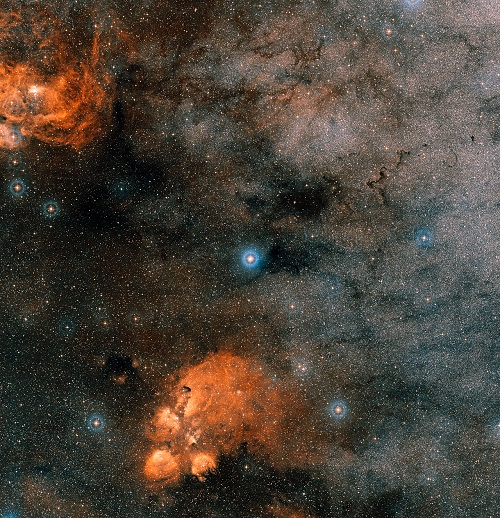
Image: This picture shows the sky around multiple star Gliese 667. The bright star at the centre is Gliese 667 A and B, the two main components of the system, which cannot be separated in this image. Gliese 667C, the third component, is visible as a bright star, very close and just under A and B, still in the glare of these brighter stars. The very subtle wobbles of Gliese 667C, measured with high precision spectrographs including HARPS, revealed it is surrounded by a full planetary system, with up to seven planets. Credit: ESO/Digitized Sky Survey 2. Acknowledgement: Davide De Martin.
Searching for Life’s Equations
In Are We Alone, a fine essay in Aeon Magazine, astrobiologist Caleb Scharf (Columbia University) places the exoplanet hunt in a cosmic context. We may be getting used to them now, but the early proliferation of ‘hot Jupiters’ and now ‘super-Earths’ was not an expected outcome at the beginning of exoplanet detection — for that matter, the pulsar planets found around PSR B1257+12 in 1991 certainly raised eyebrows as orbiting the remnant of a once massive star. Scharf points out, too, that 70 Virginis b and 16 Cygni Bb, discovered not long after the detection of planets around 51 Pegasi in 1995, were moving on highly elliptical orbits.
These wonderful finds — and news like GJ 667C delivered yesterday — keep reminding us that the old idea that our Solar System is somehow representative of what we’ll find elsewhere is deeply flawed. Says Scharf:
Many exoplanets… follow orbits that are far more elliptical than any followed by the major planets around our Sun. More puzzling still, the most frequent type of configuration, the one that has earned the moniker of ‘the default mode of planetary formation’, is that of closely packed worlds, on orbits that take mere days or weeks to loop around their stars. These compressed versions of our own system seem, for now, to be far more normal than our own. But if we’re not normal, what are we? That’s a question we can’t answer yet, because our census of stars and planets is still woefully incomplete.
Back to the habitability question. With the prospect of tens of billions of stars in our galaxy harbouring planets of Earth-size and into the super-Earth range, we live in a universe that gives us the chance to find out whether life is rare or common. Being in a habitable zone does not mean a planet sustains life, and it will be the job of our next-generation instruments to help us study planetary atmospheres so we can unlock the numbers on just what the odds are. Scharf speaks of an ‘equation for abiogenesis’ that we can search for throughout a galaxy that accommodates us by giving us a vast number of targets. We can thus take a measure of our own significance:
If we lived in a cosmos with only a few planets, we could never deduce the true probability of abiogenesis with any precision, even if they all harboured life — as imagined by earlier advocates of plurality. We might never be lucky enough to find one of these worlds within examining range, and all would be lost among the stellar fields of the Milky Way. The existence of billions of planets gives us a chance to write the equation, a chance to pin down the relationship between habitability and actual habitation.
So the excitement of finds like the planets around GJ 667C isn’t that we have yet more evidence that clement places for life can exist in the cosmos. It’s that we have another target — at 22 light years a relatively close one — that we’ll eventually be able to use as we make the crucial call on life’s equations. In the coming century, a discovery in either direction, that life is a rarity or is as common as, well, planets in the habitable zone, will have profound implications for philosophy as well as practical action. It will guide our intentions as we develop the technologies to reach other stars

Gliese 667C: Three Habitable Zone Planets
Gliese 667C keeps getting more interesting. In the past we’ve looked at studies of this star in a triple system just 22 light years away, work that had identified three planets around the star. As one of these was in the habitable zone, this small red dwarf (about a third of the Sun’s mass) quickly engaged the interest of those thinking in terms of astrobiology. Now we get news that GJ 667C may actually host up to seven planets, with three evidently in the habitable zone.
I would say Mikko Tuomi (University of Hertfordshire, UK) is guilty of a bit of understatement. He’s quoted in this ESO news release thusly:
“We knew that the star had three planets from previous studies, so we wanted to see whether there were any more. By adding some new observations and revisiting existing data we were able to confirm these three and confidently reveal several more. Finding three low-mass planets in the star’s habitable zone is very exciting!”
Exciting indeed — we’ve never found three super-Earths within the same star’s habitable zone, in this case a realm closer to the parent star than the planet Mercury in our system. The work drew on data from the UVES spectrograph on ESO’s Very Large Telescope (Chile), as well as the Carnegie Planet Finder Spectrograph at the Magellan II site in Chile, the HIRES spectrograph on the 10-meter Keck instrument on Mauna Kea, and previous data from the HARPS (High Accuracy Radial velocity Planet Searcher) on the ESO 3.6-meter instrument in Chile.
What we wind up with after a thorough analysis of the radial velocity data for GJ 667C are five signals described by ESO as ‘very confident,’ with a sixth signal that is tentative and a seventh that is more tentative still. From the paper:
— – Up to seven periodic signals are detected in the Doppler measurements of GJ 667C data, being the last (seventh) signal very close to our detection threshold.
— The signi?cance of the signals is not affected by correlations with activity indices and we could not identify any strong wavelength dependence with any of them.
— The ?rst six signals are strongly present in subsamples of the data. Only the seventh signal is uncon?rmed using half of the data only. Our analysis indicates that any of the six stronger signals would had been robustly spotted with half the available data if each had been orbiting alone around the host star.
A Densely Packed Habitable Zone
The habitable zone here is found to lie between 0.095–0.126 AU and 0.241–0.251 AU. Two planets exist on the star-side of the habitable zone, three within it, and the last two further out in the system. The assumption here, echoed by ESO, is that all five of the inner planets including the three in the habitable zone are tidally locked, with one side in permanent sunlight and the other in darkness. The skies above one of the habitable zone planets could present an interesting view indeed, as the ESO artist’s impression below conveys.

I want to look more closely at the author’s conclusions on the three habitable zone planets, starting with planet c, which is closer to the inner edge of the HZ than the Earth is in our system. Global climate here would depend upon the properties of the atmosphere:
If the atmosphere is thin, then the heat absorbed at the sub-stellar point cannot be easily transported to the dark side or the poles. The surface temperature would be a strong function of the zenith angle of the host star GJ 667C. For thicker atmospheres, heat redistribution becomes more signi?cant. With a rotation period of ? 28 days, the planet is likely to have Hadley cells that extend to the poles (at least if Titan, with a similar rotation period, is a guide), and hence jet streams and deserts would be unlikely. The location of land masses is also important. Should land be concentrated near the sub-stellar point, then silicate weathering is more e?ective, and cools the planet by drawing down CO2 (Edson et al. 2012)….
The authors describe planet f as ‘a prime candidate for habitability’:
It likely absorbs less energy than the Earth, and hence habitability requires more greenhouse gases, like CO2 or CH4. Therefore a habitable version of this planet has to have a thicker atmosphere than the Earth, and we can assume a relatively uniform surface temperature. Another possibility is an “eyeball” world in which the planet is synchronously rotating and ice-covered except for open ocean at the sub-stellar point (Pierrehumbert 2011).
And finally, about planet e, which receives:
…only a third the radiation the Earth does, and lies close to the maximum greenhouse limit. We therefore expect a habitable version of this planet to have > 2 bars of CO2. The planet might not be tidally locked, and may have an obliquity that evolves signi?cantly due to perturbations from other planets. From this perspective planet e might be the most Earth-like, experiencing a day-night cycle and seasons.
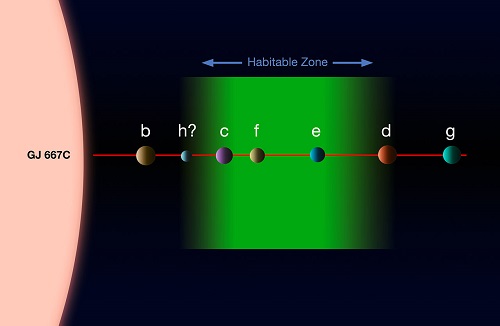
Image: This diagram shows the system of planets around the star Gliese 667C. A record-breaking three planets in this system are super-Earths lying in the zone around the star where liquid water could exist, making them possible candidates for the presence of life. This is the first system found with a fully packed habitable zone. The relative approximate sizes of the planets and the parent star are shown to scale, but not their relative separations. Credit: ESO.
Nature of the Super-Earths
As to the composition of the super-Earths around GJ 667C, the authors note the ‘packed configuration’ of the system, with all planets inside 0.5 AU, and go on to say:
…the planets either formed at larger orbital distances and migrated in (e.g. Lin et al. 1996), or additional dust and ice ?owed inward during the protoplanetary disk phase and accumulated into the planets Hansen & Murray (2012, 2013). The large masses disfavor the ?rst scenario, and we therefore assume that the planets formed from material that condensed beyond the snow-line and are volatile rich. If not gaseous, these planets contain substantial water content, which is a primary requirement for life (and negates the dry-world HZ discussed above). In conclusion, these planets could be terrestrial-like with signi?cant water content and hence are potentially habitable.
Is GJ 667C the first among many M-dwarf systems containing several potentially habitable worlds each? The authors speculate that this is the case, and if that is so, then we may ultimately learn that life is more common on worlds around these small red dwarfs than around any other class of star. It’s a notion worth thinking about, given that M-dwarfs make up perhaps as much as 80 percent of the stellar population.
It’s worth mentioning that this study includes a reanalysis of earlier data that underlines the growing power of our archived observations to inform new work. Thus Guillem Anglada-Escudé (University of Göttingen), who worked with Tuomi on this project: “These new results highlight how valuable it can be to re-analyse data in this way and combine results from different teams on different telescopes.” The new tools of digital storage and analysis mean that we are gathering data at a clip far beyond what we can exhaustively analyze, meaning that surprises may await in numerous datasets when weighed against hints from new studies.
The paper is Anglada-Escudé et al., “A dynamically-packed planetary system around GJ 667C with three super-Earths in its habitable zone”, accepted for publication in Astronomy & Astrophysics.

Centaurs and their Implications
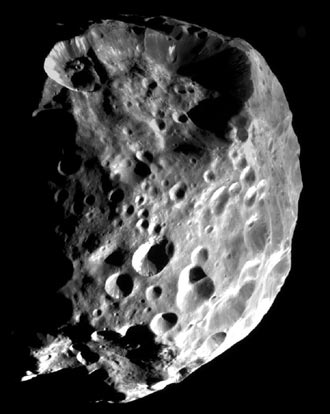
One of the themes I often use in my talks is the ‘filling out’ of our picture of the Solar System. In addition to the asteroid belt, we’ve added the icy bodies of the Kuiper Belt and the vast expanse of the Oort Cloud into what once seemed a relatively simple, nine-planet solar system. I could easily add to the ranks the population of so-called ‘Centaurs,’ small bodies that populate the space between the giant planets and show characteristics of both comets and asteroids.
10199 Chariklo is the largest Centaur yet discovered (260 kilometers in diameter), and Saturn’s moon Phoebe may be a captured Centaur, in which case images of it from the Cassini orbiter offer us our first detailed view of such an object. Both Chiron (discovered in 1977) and 60558 Echeclus show signs of a cometary coma; both are classified as asteroids and comets (as is 166P/NEAT). Although differences in definition exist, most agree that Centaurs orbit the Sun between Neptune and Jupiter and eventually cross the orbits of one or more of the gas giants.
Image: Saturn’s moon Phoebe, possibly a captured Centaur. Credit: NASA.
Now we have news from Universidad Complutense of Madrid (UCM) that Crantor, a large asteroid with a diameter of 70 kilometers orbits the Sun in exactly the same time period as Uranus. The asteroid’s orbit, says Carlos de la Fuente Marcos, one of the study’s authors, “…is controlled by the Sun and Uranus but is unstable due to disturbances from nearby Saturn.” Two other asteroids — 2010 EU65 and 2011 QF99 — are also associated with Uranus. The latter is in a stable Trojan orbit, moving 60 degrees in front of Uranus, while Crantor and 2010 EU65 show ‘horseshoe’ orbits that result periodically in close encounters with the planet.
About Crantor itself we have much to learn:
(83982) Crantor is remarkable in several respects: it is the first known minor body to be trapped in a 1:1 mean motion resonance with Uranus; it currently moves in a complex, horseshoelike orbit when viewed in a frame of reference co-rotating with Uranus; and it could be the “Rosetta Stone” for understanding why the overall number of Uranus co-orbitals appears to be significantly below that of Jupiter or Neptune. The object is placed and removed from its horseshoe orbit by the mechanism of the precession of the nodes. This precession is accelerated by the perturbative effects of Saturn. The chaotic nature of the orbit of this object constraints the degree of predictability of its dynamical evolution on timescales longer than a few 10 kyr.
The horseshoe shape of a ‘horseshoe orbit’ appears when we map the movement of the asteroid in relation to the Sun and, in this case, Uranus. While the asteroid always orbits the Sun in the same direction, it periodically catches up with the planet and falls behind again, tracing out the horseshoe outline in relation to Sun and planet. 3753 Cruithne was the first object confirmed to follow a horseshoe orbit, in this case near the Earth, while multiple objects in such orbits have been found around Jupiter, with others identified in association with Venus and Mars.
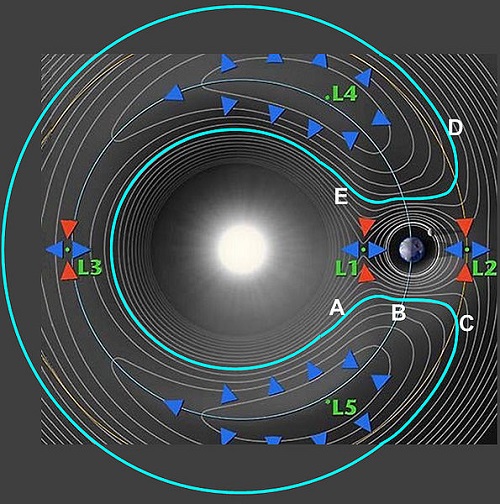
Image: A NASA illustration of a horseshoe orbit, in this case showing the orbit in relation to the Earth.
I don’t want to leave the topic of Centaurs behind without mentioning an interesting 2010 paper, although its emphasis is on Neptune rather than Uranus. Jonathan Horner (University of Durham) and Patryk Sofia Lykawka (Kinki University, Japan) make the case that a significant fraction, if not more, of the Centaur population comes from the planetary Trojan clouds, considered here as ‘stable reservoirs of objects moving in 1:1 mean-motion resonance with the giant planets…’ The researchers’ simulations show that there should be an ongoing movement of objects into the Centaur population. They go on to suggest that the Neptune Trojans could be the main source of new Centaurs. And I thought this was interesting (from their paper):
We suggest that further observational work is needed to constrain the contribution made by the Neptune Trojans to the ongoing flux of material to the inner Solar system, and believe that future studies of the habitability of exoplanetary systems should take care not to neglect the contribution of resonant objects (such as planetary Trojans) to the impact flux that could be experienced by potentially habitable worlds.
The de la Fuente Marcos paper is “Crantor, a short-lived horseshoe companion to Uranus,” Astronomy & Astrophysics 551: A114, March 2013 (abstract). The Horner/Lykawka paper is “Planetary Trojans – the main source of short period comets?,” International Journal of Astrobiology 9, 227-234 (2010). Preprint online.

Interstellar Visioneers
What does it take to conceive a new vision of the future and drive the idea forward? Keith Cooper, editor of Astronomy Now as well as Principium, the journal of the Institute for Interstellar Studies, examines the question in the context of a new book. Grand ideas aren’t enough, for the commitment to build community and expand the audience for a breakthrough are the necessary foundation. What Gerard O’Neill and Eric Drexler can teach us about this and how their example may inform the future choices of the interstellar movement are at the heart of Keith’s review. Along the way come many questions, especially this: Is a ‘failure of nerve to play the long game’ what is holding us back as we contemplate a future among the stars?
by Keith Cooper

In 1972, a think-tank of businessmen, politicians, economists, scientists and bureaucrats going by the name ‘The Club of Rome’ (they held their first meeting in the Italian capital in 1968) painted a picture of a dystopian future where by the year 2030 rising population, increased urbanisation and industrialisation, coupled with depleted resources would all mean one thing: that the planet was nearing its limits and the only way to survive would be in strict moderation, an unchanging equilibrium of austerity (a buzzword today) and restrictions. It was a depiction of a nightmare future where progress effectively shudders to a halt, yet their report, ‘The Limits to Growth’, has been read by 12 million people.
By painting this picture of a narrow, limited future, The Club of Rome inevitably spurred a reaction from the scientific cognoscenti who knew no bounds, were not defined by limits, looked to technology to create a better future and as part of their visions aimed quite literally for the sky. To folk like Princeton physics professor Gerard O’Neill, ‘The Limits to Growth’ was something to rally against and drive the proliferation of his ideas for orbiting space colonies. Humankind, O’Neill reasoned, need not know boundaries or limits if it went into space where room and resources aplenty exist. Throughout the 1970s he galvanised the public to his ideas, inspired the grassroots to form advocacy groups such as the L5 Society to keep beating the drum on space colonies, and became a media darling thanks to his vision of the future, appearing on celebrity talk shows and magazine covers.
For science historian Professor W. Patrick McCray of the University of California, Santa Barbara, author of a new book called The Visioneers: How A Group of Scientists Pursued Space Colonies, Nanotechnologies and a Limitless Future, O’Neill was an archetypal visionary with the technical know-how to present a realistic case. For McCray, having not only an idea about the future but also having the smarts to make that technological vision a reality are the essential ingredients for a ‘visioneer’, the inspirational visionary mixed with the rigorous, comprehensive work of an engineer. However, writes McCray in his book, a visioneer must do more than produce ideas and calculations; a visioneer also forms and shapes a community of supporters to promote their ideas and is both protector and promoter of the vision and the community that builds up around it.
Optimistic visions of the future
McCray’s two chief visioneers are O’Neill and K. Eric Drexler, who as a student was a member of the 1970s pro-space movement with O’Neill before going on to popularise his vision for nanotechnology in 1986 with his best-selling book Engines of Creation. Both men had ideas way ahead of their time. To O’Neill, humankind had three choices: stagnation (the choice offered by The Club of Rome), annihilation (the threat of the Cold War was serious) or expansion into space and the settlement of orbiting colonies, built from miles and miles of rotating metal cylinders. In hindsight it seems crazily optimistic but back in the 1970s it inspired the public’s imagination in a way no human spaceflight project has done since Apollo. Similarly, Drexler’s revolutionary vision of nano-scale machines reassembling matter at the atomic level, or rushing through our bloodstream to dismantle cancerous cells, is still far from being realised.
Given that we can’t yet go on holiday to a space settlement, or treat illnesses with a shot of medical nanobots, it is tempting to describe O’Neill and Drexler as visioneering failures. McCray sees things a little differently. O’Neill’s space colonies may not exist yet outside science fiction, but the community he built, signified by the L5 Society, helped spawn today’s pro-space movement in the hands of private initiatives such as Elon Musk’s SpaceX or Peter Diamandis’ Planetary Resources. Where O’Neill failed, one of these large corporations may succeed. The role of large business and billionaires is not exactly the route O’Neill envisioned, but it shows that there is more than one route to the future. Regardless, the power of a visioneer is in creating a community, inspiring people to take up the mantle further down the road if necessary. In a way it is kind of like a built-in insurance policy; ensuring ideas are passed onto the next generation so that others are sufficiently inspired to pick up the pieces should the initial visioneer fail, learn the lessons and have another go at it.
“I think the two key roles visioneers serve are to encourage the formation of communities of like-minded people to support or oppose their ideas, but also ultimately I think visioneers are best at promoting debate and discussion about what we – society – want the technological future to be like, what we hope and fear,” McCray tells me. “I see this happening more today in debates about geo-engineering, synthetic biology, drones, autonomous cars etc.”
There’s another subject to add to McCray’s list of contemporary topics: interstellar flight, an area that McCray recognises is an arena for potential visioneers. In fact it doesn’t take a huge leap to see the parallels between O’Neill’s ‘High Frontier’ and the interstellar movement and hence the possibility that we could learn something by the study of O’Neill, Drexler and other visioneers.
Courage to play the long game
In a way ‘The Limits to Growth’ provided an adversary, an alternative philosophy for the visioneers and their movements to rise up against. More specifically, it was seen by the visioneers as an attempt to reign in the great potential of human technology and progress. While today we don’t talk about ‘The Limits to Growth’ report as much – it is 41 years old after all, although The Club of Rome and its philosophies still exist – it feels like it has been reborn in different guises just as O’Neill’s pro-space movement has been reborn in the hands of SpaceX and Virgin Galactic. Today other fears replace the oil crises of the 1970s: the economic crash, a growing unease of how sophisticated technology is integrating itself into society, the battle to save the environment in the face of increasing climate change and the frictions the environmental debate causes, and the usual bouts of war, terrorism and international sabre-rattling. Limits were the enemy in the 1970s; today it is despondency leading to shortsightedness and a failure of nerve to play the long game, essential for a long term project such as interstellar flight.
An interstellar community already exists, as evidenced by the success of the Centauri Dreams website, the plethora of interstellar organisations and the now frequent symposia that draw hundreds of attendees to discuss the topic. It’s not quite as organised as the L5 Society, but it isn’t required to be; today the Internet and social media provide the glue that bind the community together; in the 1970s it was mailing lists, newsletters and local chapters in university physics and engineering departments.
However, once the community is in place and growing, and the ideas of the visioneer are being disseminated, those ideas become owned by the many members of the community. McCray describes in his book how O’Neill started to distance himself from his own community when people he deemed as undesirable joined, most notably LSD guru Timothy Leary who had strong ties with high-ranking members of the L5 Society and co-opted O’Neill’s space colonies for use in his own philosophy. Furthermore, O’Neill was angered by the producers of Sean Connery’s 1981 science fiction film Outland, set on a space colony reminiscent of O’Neill’s; Connery’s character was also called O’Neill.
Meanwhile, Drexler also faced a battle to hold onto his ideas for nanotechnology, a battle he ultimately lost. Despite often being cited by other scientists as their gateway into nanotechnology thanks to Engines of Creation, Drexler found himself sidelined by fellow academics who doubted the the engineering of nano-bots. Today nanotechnology bears no resemblance to his advanced technology, but rather is mostly just another avenue of mainstream chemistry.
“I think that the ways in which their ideas were co-opted was perhaps something they didn’t think about but was probably inevitable,” says McCray. “I also think that once you put your ideas out there and work to get attention for them, then you have to accept the fact that others will distort them, replicate them, modify them etc. O’Neill seemed to take this more in his stride than Drexler but then, with nanotech, I think there was more at stake, i.e. real funding.”
Should the interstellar community worry about losing ownership of our ideas? Next year director Christopher Nolan will release a new science fiction movie called Interstellar, rumoured to involve Kip Thorne’s wormhole physics just as Carl Sagan’s Contact did. Will our community bristle at Hollywood co-opting the word ‘interstellar’? Will we grimace at the likely bad presentation of physics and starflight? Probably, but the horse bolted a long time ago; spaceflight is a staple of science fiction. while there have also been many scientific proponents of interstellar flight over the years, from Les Shepherd to Robert Forward. Nobody owns the vision of interstellar flight; what is needed now is visioneers to make it happen. We should embrace its prominent exposure in science fiction rather than try and protect it from mainstream dissection by movie reviewers and audiences, and use that as a spur to present a more scientific take through the media.
However, what if someone were to come in and take over the whole shebang, bypassing the community entirely? A billionaire entrepreneur, one of the nouveau-rich that are trying their hand at commercial spaceflight, could easily do that. Visioneers within the community that have worked hard to refine their concepts and present them in an agreeable fashion could suddenly be kicked aside, yet in the process their role could become even more important.
As O’Neill’s vision fell apart, others today are now looking at potentially picking up where he left off. The analogy I like to make is that Hari Seldon seeded his secret Second Foundation as insurance should the first Foundation fail, which it did thanks to the unpredictable arrival of The Mule. The many organisations that populate the community today are vital because they help prolong the vision should others – including multi-billionaires – fail. It is essential that interstellar visioneers keep that grassroots support bubbling along, even in the lean times. As Icarus Interstellar‘s Andreas Tziolas said in the comments to a recent Centauri Dreams article on interstellar organisations, the community exists because “we’re sick and tired of waiting for someone else to do it!”
Yet visioneers also need patience. “O’Neill and Drexler imagined futures that they themselves would be able to partake in,” says McCray. “I see visioneers operating in this middle group, not two to three years out, but also not 200-300 years over the horizon.” Interstellar flight is a long-term goal and it remains an open question whether any of us will still be around if and when it happens. Perhaps interstellar requires a different breed of visioneer?
Capture the moment
Ultimately, the type of visioneer says something about the times they live in. Part of that is what the visioneer is rallying against. But in the 1970s, moving into the 1980s, the arena was different from what it is today, when society seemed far more open to the possibilities of the pro-space movement, popular culture embraced all kinds of spacey things such as Star Wars, Star Trek, the futuristic sounds of Jean Michel Jarre and prog-rock concept albums and the mass market science fiction paperback and magazines such as Omni, which McCray credits as being a powerful influence on the proliferation of visioneers’ ideas. Would a book like O’Neill’s The High Frontier ever become a bestseller today? Would members of the interstellar community find themselves on the cover of Time Magazine like O’Neill did in the 1970s? Instead interstellar visioneers have to work out how best to use whatever is unique about these modern times to spread the message, rather than trying to recapture glorious past times – social media is an obvious avenue. Having 100,000 followers on Twitter is surely as good as being on the cover of a magazine with 100,000 readers?
Most importantly, visioneers have to be able to build things. Craig Venter, for example, created a biological cell with a synthetic genome in his quest to create artificial biological life. O’Neill and students at MIT – including Eric Drexler – constructed laboratory prototypes of electromagnetic catapults called ‘mass drivers’ that O’Neill envisioned as vital for launching raw materials from the Moon or asteroids into Earth orbit where they could be used for construction of space habitats. Demonstrating the ability to build technology to aid a visioneer’s idea is a key part of gaining credibility. On a grander scale it might be an efficient fusion reactor or the development of human hibernation; on a smaller scale it could just involve inventing a new magnetic nozzle that aids the generation of powerful magnetic fields in a tokamak, demonstrating microwave beaming in the laboratory or creating spacecraft concepts and blueprints like Daedalus and Icarus.
The Visioneers is one of those rare books that is equally about science and personalities, a book that explores the history of visioneers but by doing so also asks questions for visioneers of the future to ponder. For anyone interested in building a better future, in pushing the envelope of technology, in developing a scientific vision, or in creating tomorrow, The Visioneers is an essential read as McCray weaves a fascinating narrative that can easily be applied to the interstellar vision. And as the biographer of the visioneer movement, what advice does McCray have for visioneers in the interstellar community?
“It would be not to limit oneself to just talking,” he says. “Build things. Develop designs. Create a community. Show people what’s possible, if only to start a discussion about what we want the future to be like down the road.”
It will likely not take a single visioneer, but many, whether working together or in rivalry, or separated by decades, but each with their part to play. Maybe some that will succeed are already here, reading this. Perhaps no one in the current community will succeed and it will fall to a new group. Or possibly it will be someone who has not even been born yet but will be inspired by the work of the community today, to whom we are entrusting the future, because good ideas never die.

On Memory and Destinations
There was a time when people collected old photographs in drawers and photo albums, a time before the digital age when you wasted three or four shots getting just the one you wanted, and the perishability of film was born home every time you saw colors fading on an old image. Yesterday I browsed through black and white snapshots of family members long gone, pictures taken in the 1920s and 1930s, and thought about how we try to preserve memory by framing a moment. Then I thought about how July 19, 2013 was itself going to be preserved, a celestial alignment snatched from time as seen from deep in the Solar System.
Carolyn Porco, who serves as imaging team leader for the Cassini Saturn orbiter, calls July 19 ‘a day for all the world to celebrate.’ Cassini will look back at our planet and snap our picture in natural color next to the fabulous system of rings and moons it’s been showing us all along. Thus a pixel from Cassini’s 1.44 billion kilometers will become an opportunity for reflection, for unlike the ‘Pale Blue Dot’ image taken by Voyager 1 back in 1990, this snapshot, actually a mosaic, has been announced in advance. I had hoped to write about it yesterday but got caught up in non-space related work and managed no post at all. But looking forward or back, the image is still worth celebrating.
Porco was part of the ‘Pale Blue Dot’ team that was so memorably treated in Carl Sagan’s book of the same name, so her thoughts have weight. Of the new effort, she says this:
“My sincere wish is that people the world over stop what they’re doing at the time the Earth picture is taken to revel in the sheer wonder of simply being alive on a pale blue dot of a planet, and to appreciate the ever-widening perspective of ourselves and our world that we have gained from our interplanetary explorations. We are dreamers, thinkers, and explorers, inhabiting one achingly beautiful planet, yearning for the sublime, and capable of the magnificent. Let’s celebrate that, and make this one day a day the whole Earth smiles in unison.”
Indeed. Narrow and wide-angle images of the Earth will be taken from 2127 to 2142 UTC (1727 and 1742 Eastern time in the US) on the 19th. Around that time yesterday, as I thought out this post, I was having a gin and tonic after a day that had proven stressful both mentally and physically. I sat out on the deck with a fine, gentle breeze rustling the trees and thought about framing moments in time, and how in one particular moment our home world — all of it — will be captured by an exquisite technology.
North America and part of the Atlantic Ocean will be illuminated when Cassini records its mosaic of the Earth as Saturn is backlit by the Sun. A 2006 Cassini image had also shown the Earth from Saturn space but this new imagery will be the first taken in natural color, as human eyes would see it, and represents the first time images of Earth and Moon have been taken with Cassini’s highest resolution camera. We should wind up with something like this:
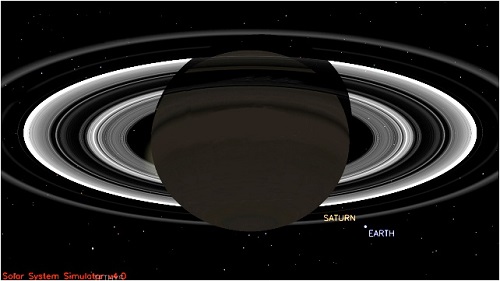
Image: A simulated view from NASA’s Cassini spacecraft on July 19, 2013, showing the expected positions of Saturn and Earth around the time Cassini is taking Earth’s picture. Credit: NASA/JPL.
The old photos in the chest in my living room are all filled with memories, people walking at the edge of a great river in western Illinois, the building where my dad built his coffee company in St. Louis, the snapshots he and my mother took on a cruise to South America. I can see relatives I only dimly remember still young, standing by Buicks and Packards, getting ready to go to war.
Our space-based images point to both past and future. Looking back at our planet frames us as a species awash in immensity, but one beginning to leave its world and reconfigure its perspective. We note the grand accomplishment of the images we take but are inevitably reminded how close Saturn is to the Earth in terms of interstellar distances. Then we compare the past images of our pale blue dot to the pixels of places we have yet to visit. Thus the haunting view of Alpha Centauri that Cassini made some five years back. Below, Centauri A and B are clearly visible over the horizon of Saturn, though the red dwarf Proxima Centauri is too faint to be distinguished.
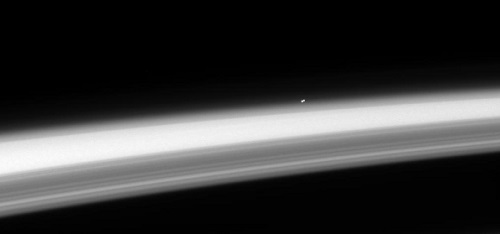
Saturn is 30,000 times closer than the Alpha Centauri stars. We have evidence of but one planet there and even that has yet to be confirmed, so we are much in the dark. Cassini’s new picture of Earth will show us our own world from a distance that renders its features as unknowable as whatever planetary systems may exist 4.3 light years away. The Cassini images of these two places are not about discovery but about reflection. They should spur our philosophy as much as our curiosity. We bring meaning to our quest for knowledge when we look both forward and back, remembering what has been and who we are, while anticipating what we are to become.

